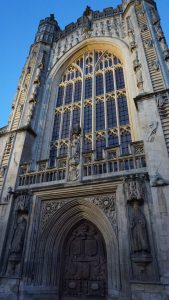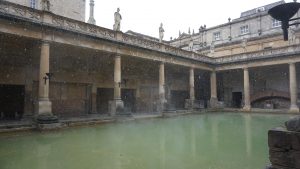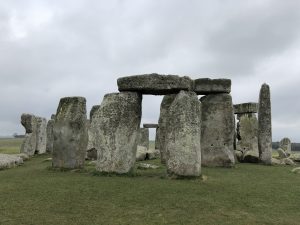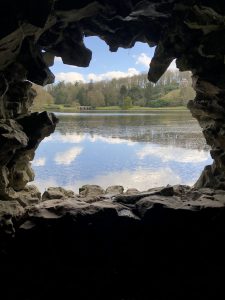I made such a correct choice of staying in Bath for one night to have a whole understanding of the entire town during day and night. I started the trip at Paddington station and rushed to my destination on a bullet train. With the beautiful sunset of Friday, I arrived, at this little town with such a uniformed architectural language. The city reveals itself as a roman town with clear Cardo and a less obvious Decumanus. The Roman Bath ruins are right at the crossing. Originally there is a temple and a forum for assembly at where now the Bath Abbey stands. The ruins shows the roman technology, glory and their sensitivity of space organization for both bathing experiences and the absolute hierarchy to the God (the temple of Claudius at Colchester).
The Bath Abbey is also astounding. I personally love it better than Westminster Abbey when comparing them both as Gothic churches. The Bath Abbey is much cleaner, purer and only designated to worshiping since it’s a pilgrimage church. With too much glory of the royal family and all the power that people want to show, Westminster Abbey give me a sense of showing off. While in Bath Abbey, with all the carving stones white or in light color, all the thanks written in words not represented in golden or colorful symbols, the devotion to Christ is fully shown.
The city itself stroke me the most with its uniformed language. It fully showed the theory that ‘if you have a good design, someone will finish it later even when you can’t finish it by yourself’. Thanks to the Woods, Bath established it’s row house language and carried one for hundreds of years. The Royal Circus is great as a self contained space, trying to establish a center, an inward facing community while the Royal Crescent made a genius move to open the circle up to views. To be honest, I was quite scornful when Jackie was talking about the how the green space in front of the Crescent and the slight change of perfect circle to half oval have brought a dramatic openness to the building and space. The shape seems simple, the green spaces seems requiring little thinking. But only until I saw the magnificent view of the city on the other side of the valley in front of the Royal Crescent, I realized that the lawn is just setting up the foreground. The view is far deeper and richer than I imagined and the slight change to oval shape have made the approaching view of the whole row houses much compelling. I was trying so hard to capture the entire view by camera but there is just no way. The breathe taking beauty of Bath is not describable and capturable. At least not by me.
By the way, I highly recommend staying in one of the Boutique hotel or some Airbnb houses in Bath so that you can get the experience of the typical row house organization.









































